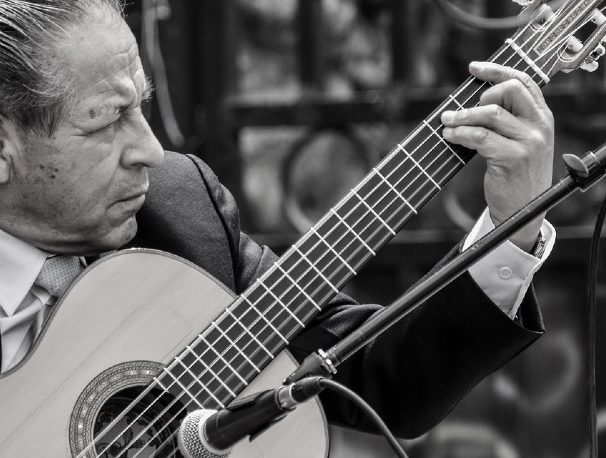
The F chord on guitar can often become the most dreaded chord for beginning guitarists. And the B chord challenges it for the title. Unfortunately, you can’t avoid the F chord for long because it plays a critical role for songs in one of the most common guitar keys, the key of C major. While it’s a little easier to avoid the B chord, you shouldn’t.
These two chords are difficult for beginners to master. And few experienced guitarists would claim them as their favorite chords to play. But learning to play them cleanly opens up a world of possibilities beyond just these chords themselves.
How important are the B chord and F chord on guitar?
Luckily you can actually get away with not playing the B chord all that often for most common guitar styles like folk, country, rock, and similar genres. Two of the three keys that require it most–B and F#–are not common guitar-based keys. And while the key of E uses it heavily as the V chord, it’s most common to play a modified version of the B chord, the B dominant 7th chord which we’ll talk about in another article.
But unfortunately, we don’t get off so easily with the F chord on guitar. Most popular guitar-based genres don’t rely too heavily on the key of F. But few keys receive more attention on guitar than C major. The folk and country genres call heavily upon the key of C. Rock also uses the key extensively.
What does the key of C major have to do with the F chord on guitar? The three main chord degrees in any song include the root, the IV, and the V. In the key of C, F is the IV chord. So any time you encounter a song in the key of C, you’re virtually guaranteed to run into a passage that requires an F chord. In fact, you’ll run into the chord over and over again through the course of the song.
So, it’s critical for every guitarist to know how to play the F chord on guitar. And, while maybe not quite as critical, you’ll leave a big hole in your playing ability if you can’t play a B chord. It’s best to make up your mind to learn both of these chords, so let’s set about doing so in a logical way that will help you progress from frustration to proficiency.
Why B and F are the most difficult major chords on guitar
Of the seven natural major chords, five of them have comfortable open positions. The B and the F chords are the two exceptions. The lack of an open shape for either of these chords makes them more difficult to play than the other five major chords.
Need to study up on the five open major chords?
If you’re a beginner who sticks mainly to the open chord positions while you learn to play the guitar, you can have real trouble with these two chords. The F chord on guitar can be especially challenging. In fact, so much so that you may well develop an aversion to playing it. The B chord presents its own set of challenges.
These two chords don’t have open shapes, and that makes them more difficult to play. That’s especially true when you’re trying to stay near the open positions for the other chords down close to the nut of the guitar. Since the two chords don’t have any open strings, you have to press several strings at frets near the nut to make the chords. Nowhere on the guitar are notes more difficult to fret than near the nut.
This isn’t quite so bad when you have open strings and comfortable shapes to help you. But these two chords have neither.
Well, there’s no way through but through, so let’s learn how to play these chords. We’ll start with more basic versions that most closely resemble open chords. Then we’ll move on to more advanced shapes that give these chords more fullness.
Eventually you’ll find that these chords are not so terrible after all. You’ll soon be able to play both of them effectively whenever you need them.
Start with basic versions
As with so many techniques on the guitar, you relatively easy basic versions of these chords exist. Until you master the more complex versions, these easier versions can get you started.
Even once you’ve become more accomplished as a player you might want to reach for these more basic versions from time to time. It all depends upon what the piece you’re playing calls for. There’s no reason to look at these more basic versions as “baby steps” or somehow inferior to the more complex chord shapes you’ll learn later.
That’s one of the most intriguing things about the guitar in general. Sometimes more complexity does not lead to the best thing to play in the given moment. To achieve the perfect sound for your piece, simplicity can triumph over sophistication. In fact, sometimes simple reveals sophistication. Knowing when to reach for which version of a chord serves as a good indicator of how accomplished a guitarist you’ve become.
Let’s learn to play the simplest forms of these two chords.
The F triad
In order to understand the F chord, let’s take a look at its makeup. The F chord consists of the the root note F, the third degree A, and the 5th degree C.
Want to know more about what makes a chord?
It’s easier than you think to learn how to play a chord on guitar
Need to brush up on triads?
As usual, a simple triad gives you your easiest options for playing the chord. You can use the E-shaped triad at fret 1 to create the F triad on the top three strings. To do that, bar your index finger across the High E and the B strings. This gives you the notes F on the E string and C on the B string. Then press the G string at fret 2 with your middle finger for the note A.
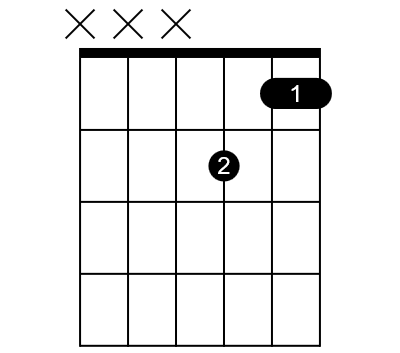
While this creates a complete and totally valid F chord on guitar, it’s not a very powerful version of the chord. If you’re playing in the key of C, your C chord (the root) and your G chord (the V) will sound full and rich. But the bottom will pretty much drop out if you use this triad shape for your F chord.
Alternatively you could play different triad shapes on some of the fatter string set. The fatter strings will certainly make the triad seem a bit richer and fuller.
However, a triad is a triad and still contains only three notes. So, no matter how you look at it, you will not match the full richness of the C and G chords with an F triad. You need something more to make the F chord more compatible with the others.
So, while the F triad serves all the possible critical functions of any other triad, it plays a more appropriate role as an accent or lead-guitar element than it does as the main rhythm guitar chord.
A more robust yet still basic F chord
You can easily add a bit more fullness to that E-shaped triad. It’s the lack of low notes in that triad that gives it its thin sound. The most common basic form of the F chord on guitar adds one note on the D string to give the chord a bit more richness.
To play this version of the F chord, start with the E-shaped triad we talk about above. As before bar your index finger across fret 1 of the High E and B strings and press fret 2 of the G string with your middle finger. Now press the D string at fret 3 with your ring finger. This adds an additional F note to the chord.
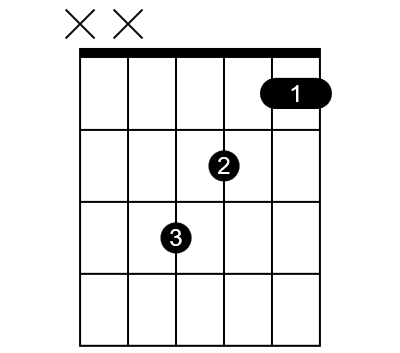
Now you have a four-string version of the F chord with an F note on the D string as the bass note of the chord. Strum these top four strings together.
While the chord now sounds fuller than the triad version, you’re still using just the thinnest four strings on the guitar. When you play this version of the chord in your C chord progression, it stands up a bit better next to the C and G chords, but it still sounds rather thin.
Still, it’s better and you can often get away with this shape in your arrangements. It’s not at all uncommon for guitarists to use this shape.
Add another C note to fill out the chord
You still have your pinky available and you can put it to use in some situations to bring another even lower note into the chord. In this shape you’ll add the C note at fret 3 of the A string to the chord.
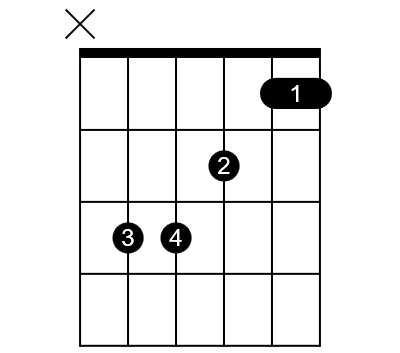
To play this shape start with the simple triad shape you’ve been using. But instead of your ring finger at fret 3 of the D string, use your pinky for that note. Then press fret 3 of the A string with your ring finger. This adds the C note in the bass of the chord.
With this shape you have a richer, fuller F chord. It uses 5 strings and the addition of the A string finally provides a strong bottom end for the chord.
However, this shape might not always sound appropriate in every situation. The bottom note of any chord plays a huge role in the timbre or “flavor” of the chord. Although this is a valid F chord shape, that C bass note gives it a strong pull toward sounding like a C chord instead.This may be just fine in most circumstances but other times it may sound just somehow not right. So you need to be a little careful with this shape of the chord.
You’ll often see this chord shape listed in chord charts as a slash chord.
What is a slash chord?
A slash chord is a chord that uses a bass not which is not the root note of the chord. It is often referred to as an inversion. The name comes from the slash that is often written after the chord name to indicate the non-root bass note. For instance, F/C indicates an F major chord with a C bass note. The slash instructs you to use something other than the chord’s root note as the bass note.
The B triad
Just as with the F chord, a B triad on the highest three strings offers the simplest way to play a B chord near the open-chord positions. In this case, instead of the E-shaped triad you use for the F chord, we’ll use the A-shape. That’s the root-position triad.
To make the B triad we need the root note B, the 3rd degree D#, and the 5th degree F#. So use your pointer at fret 2 of the High E string for the F#, your pinky at fret 4 of the B string for D#, and your ring finger at fret 4 of the G string for the B note. Play just these top three strings.
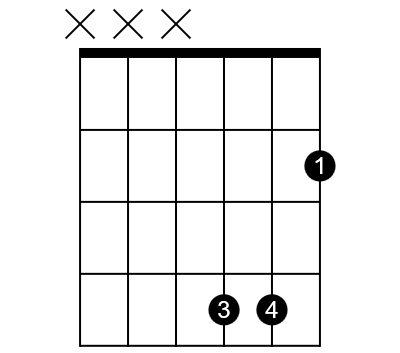
For all the same reasons we discuss above, while this creates a perfectly valid B chord, it’s thin and doesn’t always hold up against the other chords in the progression. For instance, the B chord plays a critical role as the V chord in the key of E. Given that the E root chord sounds fuller and richer than pretty much any other chord on the standard-tuned guitar, switching from that chord to a very thin B triad usually doesn’t sound great.
Adding another note to fill out the B chord a bit
And just like with the F triad, we can add another note to fill out the B triad and give it more depth. But here it gets a bit tricky. That extra note sits at fret 4 of the D string.
That means you need to hold down three strings at fret 4 while you still hold the High E string with your pointer. It’s hard to find a comfortable way to accomplish this.
Maybe the easiest way is to leave your pointer at fret 2 of the High E string. Now line your remaining three fingers up on Fret 4. Your middle finger holds the D string. Use your ring finger on the G string. Finally your pinky presses the B string.
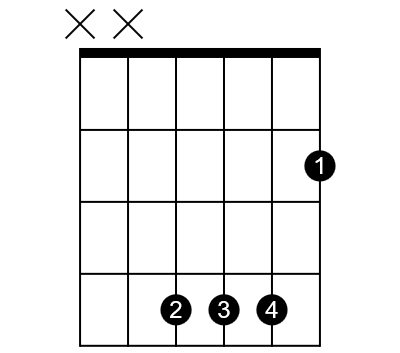
This isn’t very easy to do not only because it requires a stretch to reach all your fingers up to fret 4. You also have to squeeze three fingers fully into that fret in order to sound the notes cleanly.
As another alternative, try the ring finger on the D string. Then use the middle finger for the G string. You might recognize this configuration from the open A chord. But it’s more complicated here because of the stretch and since it’s a four-finger chord shape.
Take the next step to bar chord forms
The solution to all of the problems with both of these chords lies in the mastery of bar chords. And here is were these two chords become critically important to any guitarist who wants to progress beyond the very basics.
You can make these chords with two different bar shapes. As it turns out, these two shapes are among the most important shapes of all on guitar. This is exactly why it’s so critical to learn these two chords.
Let’s take a look at how to make the chords first. Then we’ll talk about why the shapes you are about to learn are so important.
The F bar chord
You’ve already used the concept of a bar chord. When you made the simple F triad, you laid your ring finger across the B and High E strings. That’s a bar chord. Any time you lay one finger across more than one string, it’s a bar chord.
But there’s a more full version of the bar chord that you can use to make an F. And it’s the bar chord to rule them all.
To create a bar-chord F, lay your index finger across all six strings at Fret 1. This won’t be easy for you at first, but don’t worry, you’ll use other fingers to take some of the work off of your pointer.

Now, press fret 2 of the G string with your middle finger. Press fret three of the A string with your ring finger. Finally push fret 3 of the D string with your pinky. Since your other fingers push down the A, D, and G strings, the bar with your pointer need really only press the two E strings and the B string, but it will touch them all.
This is going to take some time and practice. Make sure to position your thumb directly below the bottom of the neck. You need to squeeze your pointer and thumb together in order to achieve the pressure you need with the pointer.
Start slowly and don’t overdo it. When your thumb gets tired or starts to hurt, stop! Rest your hand and come back later to try again. Work up gradually to being able to hold this chord. If you push it you could seriously damage the muscles in your hand. So be smart and go slow.
The B bar chord
The full-bar B chord presents an even greater challenge in some ways. For this chord you again need to bar with your pointer. But this is a double-bar chord. At least in its most common fingering.
To play the B chord, bar across fret 2 with your pointer. However, make sure you don’t include the Low E string. That string does not belong in this chord.
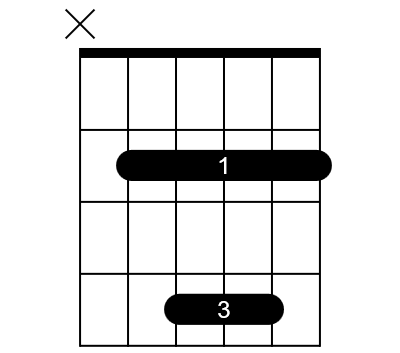
Now use your ring finger to bar the D, G, and B strings. It’s going to be very uncomfortable at first, but keep working on it. That is, again, until your hand gets tired or starts to hurt. Stop and rest before you injure yourself.
It’s a bit tricky to bar the D, G, and B strings with your ring finger and keep it out of the way of the High E string. The pointer needs to hold the A and High E strings, so you can’t let your ring finger touch the High E. It’s definitely not easy and it will take patience and work.
Some players use their pinky to bar the D, G, and B strings. I honestly cannot figure out how they can do that, but some do. Try it and see if it works better for you.
Still other players don’t play that second bar at all, but instead use their three remaining fingers to press those strings individually. This requires quite a stretch, and I don’t recommend it for that and other reasons.
These two chords are critically important beyond the chords themselves
So you can see that these chords are challenging. So much so that likely most beginner guitarists have to fight the temptation to ignore them. But as I said, they are among the most important shapes in all guitar so stick with it.
But why are they so important?
You might have noticed something peculiar about these two chords. They’re really just two other chords in disguise.
The F chord uses the exact shape of the open E chord. You just move that shape up one fret. And since you moved those fretted strings up a fret, you also need to move the open strings from the E chord up a fret. You use the bar with your pointer to do that.
Likewise, the B chord uses the exact shape of the open A chord. Since you move the fretted notes of the A chord up two frets, you need to bar across fret 2 in order to raise the open notes too.
And that’s the very concept of a bar chord. You raise a familiar shape to a new location on the neck and use the pointer bar to raise the open notes accordingly. In actuality, you can do this with any open chord shape, but the E and A shapes are the easiest and most useful. And there fore, the most common.
We’ll talk about bar chords more extensively in another article. For now, take my word for it that you will use these two shapes countless times in your playing career. So start now to learn and master them.
Conclusion
It’s critical to lean the B chord and the F chord on guitar. They present more of a challenge to new guitarists because they don’t have easy open shapes.
You can start with simple triads for both of them. While this works fine, the resulting chords can sound thin and weak when play along with other open chords in the progression. To solve this, you can add another note or two to each of them.
The most useful way to play these two chords involves using your pointer finger to bar across most or all of the strings and then add familiar shapes with your remaining fingers.
The F chord uses the open E shape, while the B chord uses the open A shape. These two shapes are among the most important shapes on the guitar. Take your time while learning them so you don’t injure yourself. But do take the time to learn and master them. Your efforts will pay high dividends.
